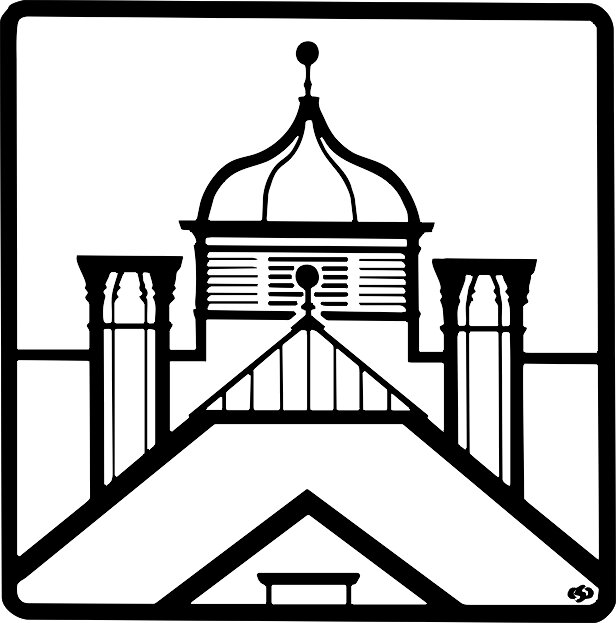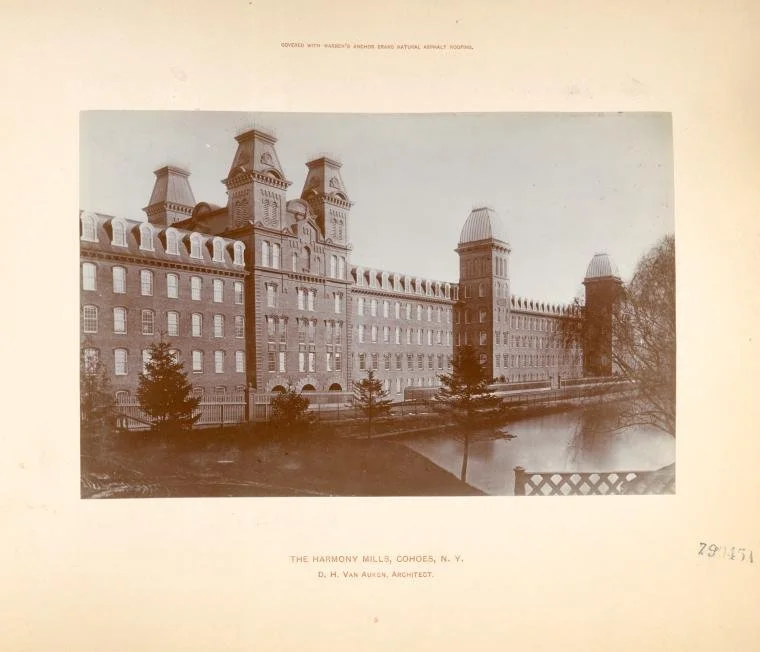Newsletter - Summer 2023
Our Summer Newsletter reports that the reimagining of the Burden Iron Works Museum exhibit space is progressing nicely, and we expect to re-open the museum on at least a limited basis later this summer. Hooray! In addition, we expect to be able to award contracts for museum renovations funded by our New York State grant soon, and we have received funding for several other projects. This newsletter also includes stories on the loss of two local church bells cast in Troy, the origin of the Gateway’s Rototiller collection, and the potential inclusion of textile mills such as Harmony Mill in Cohoes in the UNESCO World Heritage Site program.
Progress Continues on Museum Reorganization; “Soft Opening” Planned for Mid-Summer
The reorganization of the museum floor is proceeding. We hope to be able to open for visitors on a “soft opening” basis by mid-summer. Several key exhibits are under construction and will act as the focus for the new floor arrangement. Graphic design firm Design for a Small Planet’s Michael Chrisner and his staff are working on a brand-new visitor guide for distribution to guests. The new guide will give patrons a self-guided tour of the museum floor and will be a great souvenir. We appreciate your patience as we work towards reopening.
Burden Iron Works Museum handicap ramp rehabilitation in process
Gateway Receives Federal Project Funding Through City of Troy
The Gateway has received $30,000 in American Recovery Plan Act funding through the City of Troy. This funding was first applied to rebuilding our 15-year-old handicap ramp. The work on the ramp was badly needed and will make access/egress from the museum much safer and more pleasant. The ramp should be completed by the time you read this. We have also applied for a grant from the Troy Cultural Alliance to begin work on a new exhibit room at the Burden Iron Works Museum to highlight our collection of precision instruments, primarily those produced by Troy firms W. & L.E. Gurley and Geier & Bluhm.
Sign at Burden Iron Works Museum announcing NYS project funding
State Grant Nears First Disbursement
If you’ve stopped into the museum lately, perhaps to see the steam engine or check out the ladle car, you might not have noticed the new sign on the side of the building. It isn’t conspicuous, but it does augur great things for us here. In short, it is the notification that we are a site being funded by New York State Environmental Protection Fund dollars that will help to move the Gateway forward on several important fronts.
Mesick Cohen Wilson Baker Architects have finished their preliminary work on the drawings and project descriptions required for the EPF funding. These are currently under review by the New York State Historic Preservation Office. The next step after SHPO approval will be to put the various projects out to bid. These will include the main masonry staircase, the HVAC system, the building envelope including doors and windows, and possibly some flooring inside the museum main space. We are excited that the work will go forward and may even begin this calendar year.
Capital Region Loses Two Church Bells
Last spring the Capital Region lost two locally cast bells. One bell was lost in the Kenwood fire, and a bell in Malden Bridge was, somewhat surprisingly, stolen.
A March 23 fire destroyed the former Sacred Heart Convent and Female Academy, built in Albany in the 1850s on the grounds of the old Kenwood Estate. Also lost in the fire was at least one bell cast in Troy. According to Gateway records, the Convent of the Sacred Heart purchased a bell from the Jones Bell Company in Troy on October 25, 1867. The bell weighed just over 1,000 pounds. Also in our records is this testimonial from Sacred Heart Chaplain Thomas Walsh: "I take the liberty of commending Messrs. Jones & Co., of Troy, as Bell Founders, who are artists of great experience in their business." All that remains of this bell are the cast iron yoke and clapper. There were also two smaller bells in the steeple that were totally melted by the heat of the fire.
After losing a Jones bell to the Kenwood fire in late March, we were sad to learn of the loss of another local bell – this time by theft. A Meneely & Kimberly bell and its yolk displayed outside the Malden Bridge Community Center in Columbia County was stolen in late April. The 1,248-pound bell was cast in 1878, and it is relatively rare Troy bell as Meneely and Kimberly were partners for only 10 years. The bell was originally cast for the Methodist Church in Old Chatham. This church was razed in 1960. The bell was relocated to the Wesley United Methodist Church in Malden Bridge in 1975; this church later became the Malden Bridge Community Center. Despite a $3,500 award offered by the community, no news about the lost bell has surfaced, and it is feared that the bell may have been melted down.
Gateway Vice President Allen Cluett , President Fred Alm, and Executive Director Emeritus Michael Barrett wrestling with a Rototiller during one of the moves
The Origins of the Gateway’s Rototiller Collection
It began in the year 2000 when bankruptcy abruptly stopped rototiller production at Garden Way Inc.’s Troy factory at 102nd Street and Ninth Avenue (currently the Ross Technology Park). “Just like that!“ was an often-heard comment around town. Garden Way’s sudden closure posed an immediate challenge for the keepers of Troy’s industrial history, especially since the bankruptcy required immediate decisions on the disposition of the company’s records and its collection of historic Troy-Bilt Rototillers. Where would this important material go? The Rensselaer County Historical Society (now the Hart Cluett Museum) graciously offered emergency housing for the rototillers, and the RCHS and the Hudson Mohawk Industrial Gateway further agreed that the Gateway would have long-term responsibility for the rototiller collection while the RCHS would archive the company’s records.
The Gateway Board was now faced with an important decision: how did this acquisition fit into their goals? The original charter emphasized the museum’s mission to document the details of our local contributions to the Industrial Revolution, but these were rooted mainly in the 19th and early 20th centuries. At its inception, the Gateway was tasked to accept, study, and document early manufacturing and production of iron, steel, cloth, glass, paper, and related industries. Accepting Garden Way’s Rototiller collection stretched the chronological focus to the later 20th century.
The author, Allen Cluett and friends at the New Jersey Rototiller event, 2017
Since Rototiller began in 1930, and Garden Way came along about 1962, they were both clearly outside the Gateway’s initial collection focus. However, between the two manufacturing operations, they produced well over one million Rototillers and sent them to customers from coast to coast putting Troy, New York, on the nation’s industrial and agricultural map. It is fair to say that much of the locally gained technological skills of our early industrial years went into the production of this “mechanization of agriculture” scheme here in our top-of-the-Hudson River town. Is it still a stretch? Moreover, our museum was supported generously by Garden Way in the past. Nonetheless, this was an extensive collection to assimilate so suddenly, but where else could a collection like this land?
The decision to accept the collection was made because the manufacture of such important machinery could not be more Industrial or Revolutionary; the rototiller plowed, disc-ed, and harrowed in one easy operation. The utility of this machine was provided by the Hudson Mohawk region of New York State….to the world. So, we stretched.
For the next twenty years our museum struggled with Rototiller paraphernalia. Boy, did we struggle! We moved this caliginous collection five times: from Brown’s Brewing to a farm in Schaghticoke to Harmony Mill in Cohoes to Troy’s Gas Holder House and last to Bearing Distributors in Troy. The necessary labor was provided by Gateway volunteers and trustees.
And, after consideration of the size of the collection and the existence of duplicate items, we held an auction on eBay, to the delight of many enthusiastic collectors. This culled the assemblage to a more manageable size. After the auction the remaining rototillers and related paraphernalia were brought to the Gateway’s Burden Iron Works Museum.
Over this period, we became aware that collectors were focusing on our “Rototiller” and “Troy Bilt” brands as important “County Fair Show Piece Attractions.” Les Miller, of Glen Rock, New Jersey, had collected and restored examples of every Troy Rototiller. Charlie Zuck of Pennsylvania (zucksrototillers.com) collected all the Troy Bilt models. Each year since 2012 Miller has hosted an enthusiastic swap and trade meeting.
Exactly one week after returning from Miller’s 2023 annual roundup, I was shopping at Troy’s “Best in the Nation” Farmers Market with my daughter, Daisy. We stopped at the Placid Bakery stand. There was Kari, who said,” Oh, I missed you last week – I had a loaf of sourdough set aside for you”. Daisy replied, “Well, he was in New Jersey for his annual Rototiller Conference, and …!” Kari took a step backward, slapped the side of her face suppressing something between astonishment and laughter, and cried, “Oh, is there REALLY such a thing?”
After an eternal second, we trudged along, saying, “Yes, Virginia, er, Kari, there REALLY is …”
This article was written by John R. Pattison, a former Garden Way employee and long-time Gateway supporter. John’s sister-in-law, Ellie Pattison, was one of the founders of the Gateway.
Textile Mills Could Become UNESCO World Heritage Sites
The United Nations Educational, Scientific and Cultural Organization manages the process of designating World Heritage Sites. These are usually sites of outstanding natural beauty or buildings or areas that represent remarkable accomplishments of humanity. There are presently more than 1,500 World Heritage Sites globally. Twenty-four are in the United States. Most are natural areas such as national parks. A few structures are listed, including the Statue of Liberty and Independence Hall, but no U.S. industrial buildings are listed.
UNESCO has started the process of identifying additional industrial sites that could be nominated by national governments as World Heritage Sites. The organization tapped The International Committee for the Conservation of the Industrial Heritage (TICCIH) to lead a multiyear process to develop a global list of textile mills for further consideration.
TICCIH identified more than 600 textile industry sites in nearly 500 locations in 67 countries during its research conducted from 1998 to 2021. Its work was recently published in the book The Heritage of the Textile Industry. “Without doubt the list is far from complete,” the book concluded. In particular, the number of U.S. textile centers listed – 16 – seems rather skimpy. This may be because the U.S. was not a member of UNESCO throughout the entire study period. (Former President Trump withdrew the United States from UNESCO; President Biden has decided to rejoin the organization.) The large textile mill centers in New England are included of course, including mills in Lowell, Lawrence, Fall River and New Bedford, Mass., as well as America’s first integrated cotton mill, Slater’s Mill in Pawtucket, R.I. Troy is included, but strangely not Cohoes with its Harmony Mill complex.
The TICCIH list is not final; additional sites can be added. A country may nominate sites for World Heritage Site designation. UNESCO will then consider whether they meet established World Heritage Site criteria, and then approve them if they do. The World Heritage Site designation is purely honorific: it does not come with any funding. Supporters of the World Heritage Site program believe, however, that the added prestige of the designation raises a site’s profile and attracts additional visitors.











